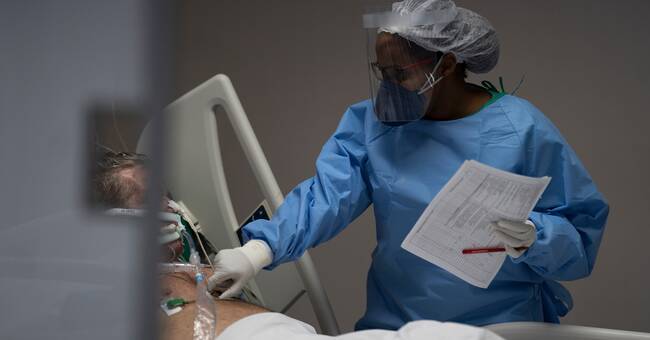The number of patients in hospital due to covid-19 is increasing.
The same for the number of seriously ill patients who require intensive care (iva).
- The number of admitted patients is going straight up.
We have also received IVA cases extremely quickly, it goes very fast here, said Signar Mäkitalo, infection control doctor in Region Sörmland, recently.
The picture looks almost the same in all of the country's 21 healthcare regions.
The spread of infection is increasing sharply, and thus also the number of patients who end up in hospital.
But unlike last spring, mortality among those who end up in hospital has fallen sharply since the beginning of the pandemic.
In addition, there is a strong hope that the decline will continue, even during the coming winter.
- It is a big difference.
Among us who work with this, it feels much more hopeful than last spring.
The feeling is that things are going much better for the patients now.
Both in IVA and in the wards, says Ola Blennow, infection doctor at Karolinska University Hospital in Huddinge.
Javascript is disabled
Javascript must be turned on to play video
Read more about browser support
The browser is not supported
SVT does not support playback in your browser.
We therefore recommend that you switch to another browser.
Read more about browser support
Fia Börjesson is an IVA nurse in Stockholm and is worried that things will be just as bad as last spring.
Photo: SVT
Does not always sleep down
It's more than a feeling.
A Swedish registry study presented at the end of October shows that mortality among all those cared for in hospital for covid-19 decreased from 24.7 to 13.3 percent between March and June, calculated up to and including 60 days after the diagnosis.
During the same period, the mortality rate among those cared for with the help of intensive care decreased from 36 to 20 percent.
A dramatic reduction, in other words.
According to Ola Blennow and his colleague, the infection doctor Hilmir Ásgeirsson, the explanation is a better care of the patients, both in terms of medication and other treatment.
- In the past, patients were usually quickly anesthetized and intubated when they came to IVA.
Partly because you were afraid of spreading the infection, partly because that is how you usually do it.
But gradually we have learned that many of these patients can often survive for a very long time with just oxygen.
Can be spared from tough treatment
The patients, he says, get oxygen with the help of a high-flow halter in the nose.
They are still very ill and they need so much oxygen that they can not be anywhere else but on iva, but they do not have to be put to sleep and breathe with the help of a tube in the throat, which is connected to a respirator.
In this way, some patients can be spared from a treatment that can be so stressful for the body that the treatment itself can pose a risk.
- Instead, they can lie down and text with their wife, says Ola Blennow.
This has resulted in only a quarter of the inpatient covid patients at the intensive care unit in Huddinge being intubated at the moment.
- Another important thing is abdominal position, that we turn certain patients on their stomachs.
This improves the oxygen exchange, says Hilmir Ásgeirsson.
Patients receive Remdesivir
The medication has also improved.
In the spring, it began to be understood that many patients with covid-19 are at risk of developing blood clots, especially in the lungs.
- That is why we give all patients clot-dissolving treatment for preventive purposes, says Ola Blennow.
In addition, patients also receive the antiviral drug Remdesivir.
- We have started to use belt straps more and more.
It is not for everyone, but for the right patients and at the right time, early in the process, it can have an effect, says Hilmir Ásgeirsson.
Time and factor
Later in the course, anti-inflammatory cortisone can also be used.
- When the first virus phase is over, inflammation becomes increasingly important, and then cortisone is a good medicine for the most seriously ill, says Ola Blennow.
In addition, it seems that patients come in earlier now, than they did last spring, in a different phase of the disease, in other words, which also increases the chances of survival.
Another important lesson is the importance of time, that the vast majority of patients turn sooner or later.
- In a majority, the lungs recover, but it takes time and we must give the body the time it needs, says Ola Blennow.

